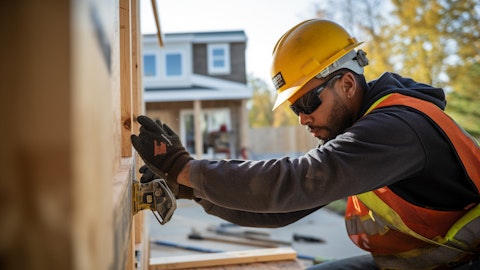Michael Miller: Yeah I definitely see great opportunity in 2024. I mean you always kind of look across the business and what we call the end markets. I mean we believe that through 2024 the greatest opportunity for organic growth will be in single-family markets, right? But now I want to back that up a little bit and just say our multifamily backlogs continue to be very strong, extremely strong. What we would at a macro level expect the multifamily it starts to come down fairly significantly in our call it 12% to 13% from 2023. We have a lot of confidence around our ability to continue to take market share and continue to perform on the existing backlog that we have such that we continue to perform much better than the market opportunity on the multifamily side but single-family nearly as everyone’s talking about there’s just tremendous potential there this year.
Stephen Kim: Yeah. And so I think that that all makes sense. You know switching. So switching to the resi side of your business, multifamily, the backlogs being very strong I think you had previously said you expected that to sort of be a driver to your business all throughout 2024 pretty much. And can you talk about the margin profile there? I mean obviously the margins have been extremely strong. Your margins in the quarter and the year were strong and kind of above I believe what you had sort of said was your sort of a long-term outlook for gross margins of 30 to 32. You’re running well above that. Was curious is, if we would – what you would attribute that to? Is that something where you still feel 30 to 32 is the right range or maybe given some things that you’ve seen, we could scoot that up a little bit.
Just trying to get some color on your outlook for gross margins, whether it’s changing maybe going up a little higher and whether multifamily is playing a role in what we’re seeing right now?
Michael Miller: Yeah, that’s a great question. And I would say that, we are definitely encouraged that the gross margin improvement has been solid. There’s no doubt though that, as we expect to happen and certainly has even happened in January, as we get higher growth rates from the production builders, the big national builders, purchase great business. We love that business and we saw good growth with that in January relative to the regional and local guys, we would expect that that would put pressure on gross margin but ultimately the EBITDA margin contribution is similar. But in terms of overall on the gross margin side the team has done a phenomenal job of really focusing on providing as much customer value and service as possible to enhance profitability on it across the company.
So as we look at the business, particularly through 2024. And if I look at say the fourth quarter of 2023 I mean we’ve been able to work very hard to get the multifamily margins up because historically, several years ago they would have been a drag on margin. Our team has done a great job of not having them be a drag on overall margin. And the other thing that helped us, particularly in the fourth quarter is that while the rate of growth was better for the insulation products than the other products, the other products which we’ve talked about on several times do have lower margins than insulation, but their margin improvement was better than — considerably better than the margin improvement in insulation. And as a consequence, did help was a benefit to gross margin.
Again, we don’t think that’s transitory either and that’s sustainable. So, it definitely makes us feel confident around the gross margin being closer to 32 than 30.
Stephen Kim: That if I could just follow up there, these non insulation products, the margin improvement, you think is sustainable. Can you give a little more color on or some examples of sort of what drove that and why it’s sustainable?
Michael Miller: I think there are several things, the inflationary environment becoming more benign, the availability of material becoming more normalized. And honestly, I mean we say it a lot, but it absolutely is true. It’s the performance of the team. I mean, our field team has executed so effectively, in times that have been very difficult when we think about, what’s happened over the past couple of years between COVID, the supply disruptions this year the challenges that single-family presented that we’re all well aware of, I mean the team has just done an outstanding job and their focus on profitability, we believe is reflected clearly in the numbers.
Stephen Kim: Great. Thanks so much guys.
Operator: Thank you. Our next question comes from the line of Joe Ahlersmeyer with Deutsche Bank. Please proceed with your question.
Q – Joe Ahlersmeyer: Hey, good morning, everybody. Thanks for taking the question and congrats on the results. I’m trying to think through, where do expect the most strengthen year-over-year sales growth within single-family for the year? Maybe if you could just talk about, what you’ve seen in starts in the fourth quarter and into January in the data, how you maybe expect that to come to your stage of construction right, the installation part. And then, also in the context of what the comps were last year. I think you’ve previously spoken to 2Q being the maybe the easiest comp. So maybe it might take into the second quarter, before we really see single-family start to expand year over year?




